Exploring the Dimensions of Art Puzzle Apps
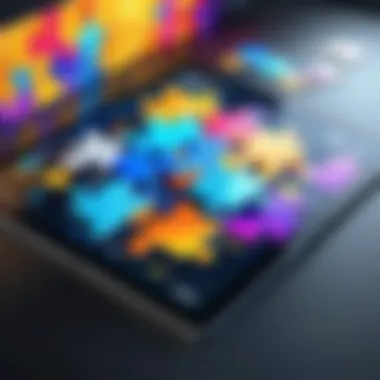
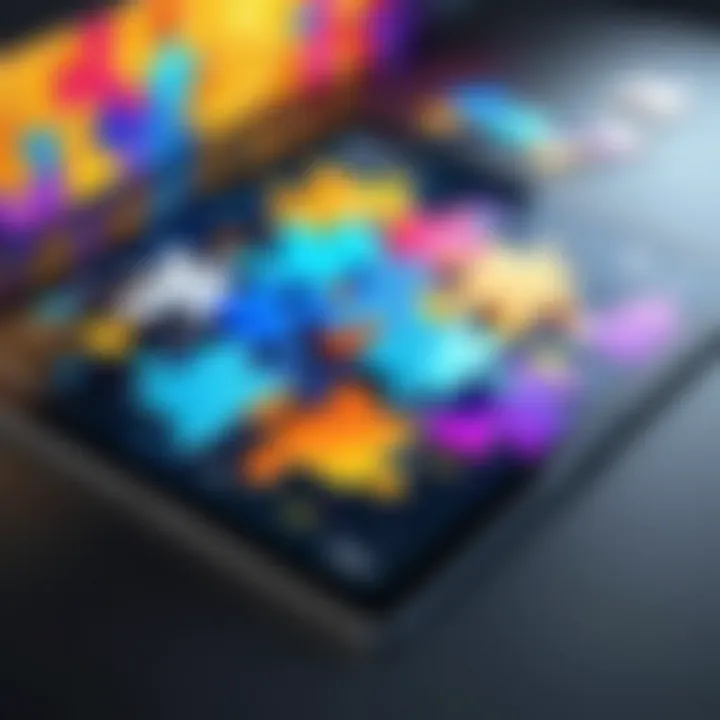
Intro
The rise of art puzzle apps marks a significant shift in how users interact with art in the digital age. These applications combine the enjoyment of puzzles with the appreciation of art. They not only entertain, but they also educate users about famous works and artists. This exploration unpacks the intricate intersection of technology and art, particularly how these apps can influence both enjoyment and understanding of artistic expressions.
Technology Insights
Latest Tech Trends
As the market for art puzzle apps continues to grow, it aligns with several technological trends. One notable development is the increasing use of augmented reality (AR) in app design. AR enhances the user experience by allowing users to see artworks in a personalized way, transforming their surroundings into an engaging canvas.
Additionally, machine learning algorithms enable tailored recommendations based on user preferences. For instance, if a user frequently engages with impressionist art, the app can suggest related puzzles or themes, creating a more immersive experience.
Innovation in Tech
Within art puzzle apps, innovation is fueled by user demand for unique experiences. Developers are now integrating interactive features that go beyond simple jigsaw puzzles. For example, some apps also include mini-games or trivia about artwork, bridging the gap between entertainment and education. This dual approach enhances user engagement and promotes deeper appreciation of art.
Moreover, multi-platform usability has become paramount. Shifting from mobile to desktop seamlessly offers flexibility. Users can work on puzzles in various environments, whether at home or on-the-go.
Product Reviews
Several art puzzle apps stand out in the marketplace. Artful Puzzles combines beautiful art with puzzles that scale in difficulty. This ability allows users to choose how challenging their experience will be, catering to a wider audience.
Another notable mention is PuzzleArt, which highlights a specific artist each month. Users are encouraged to explore new styles and movements while solving engaging puzzles.
Benefits of Art Puzzle Apps
Art puzzle apps offer numerous advantages:
- Enhanced Cognitive Skills: Users boost problem-solving and critical thinking.
- Art Appreciation: Engaging with puzzles cultivates knowledge of artists and their techniques.
- Community Engagement: Many apps offer forums or social sharing features to discuss strategies, enhancing user interaction.
"Art puzzle apps are not just games; they are tools for art discovery and community building."
Foreword to Art Puzzle Apps
Art puzzle apps represent a unique confluence of creativity and technology. They offer users an innovative way to engage with art through interactive puzzles, transforming the traditional experience of viewing art into a participatory affair. In this article, we will explore the importance of art puzzle apps in today's digital culture, emphasizing their significance in promoting art appreciation and enhancing cognitive skills.
Art has always been a medium for expression, and with the rise of mobile technology, the accessibility to art has vastly expanded. Art puzzle apps create a platform where users can interact with artworks in a dynamic and engaging manner. This section will highlight specific elements such as their ability to provide educational content, integrate historical context, and stimulate creativity within the user.
One primary benefit of art puzzle apps is their capacity to make art more approachable. For many, the world of art can feel exclusive or intimidating. These apps help demystify this realm by encouraging users to piece together famous paintings or sculptures, often learning about the artists and their techniques in the process. Therefore, they play a crucial role in bridging the gap between the art community and the general public.
Considerations about the introduction of these apps should include their appeal to diverse audiences—from casual viewers to art enthusiasts. They cater to various interests and levels of expertise, making them suitable for a wide range of demographics. As we proceed through this article, we will delve deeper into the different features, benefits, and the technology propelling these art puzzle apps forward.
"Art puzzle apps are more than just games; they are a tool for education and appreciation in the art world."
In summary, art puzzle apps signify a transforming moment in how we engage with art. They foster not only enjoyment through gameplay but also a deeper understanding of the artistic landscape. By examining this topic, we lay the groundwork for understanding how these applications enrich our lives while nurturing a sense of curiosity and creativity.
Understanding the Concept
Understanding the concept of art puzzle apps is fundamental to grasping their role within the modern intersection of technology and creativity. These applications serve more than just entertainment; they become avenues for users to engage with art in a playful yet thoughtful manner. The fusion of traditional art appreciation with innovative tech caters to a diverse audience, from casual users to serious art lovers and educators. It transforms the way art is accessed, experienced, and understood. In this section, we will unpack the definition, explore the scope, and analyze how art and technology converge.
Definition and Scope
Art puzzle apps can be defined as digital platforms that allow users to solve puzzles based on various artworks. This might include rearranging sections of famous paintings or completing visuals inspired by artistic movements. The scope of these apps is vast, as they incorporate diverse art genres, ranging from classical art to contemporary pieces. The apps offer users not only the challenge of puzzles but also insights and educational content about the artwork being displayed.
With a growing collection of global artists and styles, users have access to a wide variety of artistic experiences. The definition of art puzzle apps extends beyond mere games; it encapsulates a holistic approach to art education and appreciation.
Art and Technology Convergence
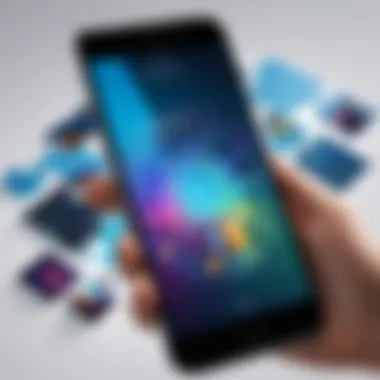
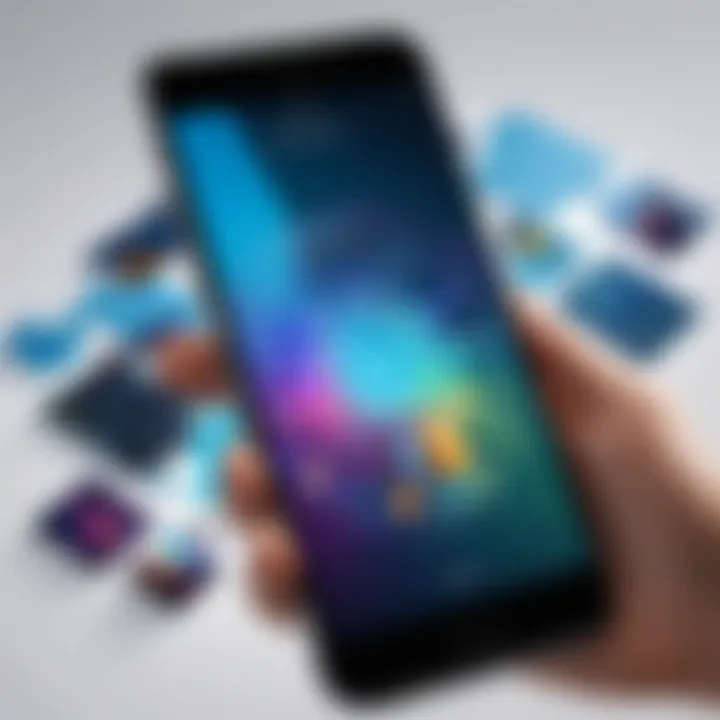
The convergence of art and technology has shifted how individuals interact with the art world. It is crucial to acknowledge how technology enables art appreciation through interactive experiences. Art puzzle apps play a significant role in this transformation by using advanced digital tools that make art more accessible and engaging.
- Augmented Reality (AR): Some apps incorporate AR features, allowing users to visualize art in their own spaces, enhancing the connection between the digital puzzle and the physical world.
- User-Centric Designs: Enhanced user interfaces optimize the experience, tailoring difficulty levels and offering user feedback to create a dynamic interaction with the artwork.
The fusion of these elements opens doors for education and personal growth. For instance, users often learn about an artist’s techniques while solving a puzzle related to their work, thus deepening the understanding and appreciation of art.
Art puzzle apps are not just entertainment; they are educational tools that make art accessible to a broader audience.
This convergence reflects a significant cultural shift. It embraces innovation while respecting the traditional values of art, encouraging a deeper engagement from a tech-savvy audience. Overall, this section lays the groundwork for understanding the profound impact of art puzzle apps in the realm of art appreciation and education.
Features of Art Puzzle Apps
Art puzzle apps have rapidly gained traction due to several features that enhance user engagement and satisfaction. Understanding these features is essential because they directly impact the user experience. By examining specifics like user interface, puzzle difficulty, and art collection variety, we can see how these elements work together to create a compelling digital product.
User Interface and Experience
The user interface of an art puzzle app plays a crucial role in shaping the overall experience. A well-designed interface allows users to navigate through puzzles effortlessly. Clarity is important in visual design, as it helps users focus on solving puzzles without distraction. For example, apps like Jigsaw Puzzles - Puzzle Game offer intuitive layouts that allow for straightforward interactions, which helps in engaging a diverse audience.
Moreover, the customization options in the user experience can enhance enjoyment. Users often find satisfaction in adjusting background colors or piece shapes to their liking. Providing a seamless experience guarantees that users are more likely to return and recommend the app to others.
Puzzle Difficulty Levels
Another essential feature is the difficulty levels available within these apps. A well-thought-out range of puzzle difficulties allows for a broader audience appeal. Users can choose from easy puzzles that serve as a warm-up for beginners, to more complex designs that challenge even seasoned puzzle solvers. This variety is important because it caters to different skill levels and preferences, ensuring that the app remains useful for a wide group of individuals.
Benefits of diverse difficulty levels include:
- Progressive Learning: Users can gradually improve their skills.
- Retention: Users may stay engaged longer as they strive to complete more challenging puzzles.
- Accomplishment: Completing a difficult puzzle fosters a sense of achievement, enhancing overall enjoyment of the app.
Art Collection Variety
The art collection variety found in these apps greatly enhances their appeal. Users are likely to be more engaged if they can choose from a wide selection of art styles and genres. Whether it’s classic paintings, contemporary works, or even digital art, the scope for exploration is broad.
Apps like Art Puzzle feature collections that range from famous masterpieces to lesser-known works, enriching the user's interaction with art. This variety not only keeps users entertained but also provides an educational component. Users may discover new artists or styles, leading to a deeper appreciation of art itself.
Benefits of Art Puzzle Apps
Art puzzle apps offer various advantages that extend beyond mere entertainment. They blend engagement with cognitive and emotional benefits, while also fostering a deeper appreciation for art. In this section, we will explore three key areas where these apps add value: cognitive skills development, art appreciation and education, and mindfulness and relaxation.
Cognitive Skills Development
Engaging with art puzzle apps can significantly enhance cognitive skills. As users navigate through puzzles, they exercise their problem-solving abilities. They learn to recognize patterns and develop spatial awareness, both of which are crucial for critical thinking. The interactive nature of these apps demands the user to think strategically. For example, completing a puzzle not only requires assembling pieces but also foreseeing how each piece fits into a larger picture.
By engaging with art through puzzles, users also improve their memory. Remembering the position of various pieces and recalling past experiences with art can boost cognitive retention. This combination of memory, strategy, and problem-solving skills makes these apps a beneficial tool for cognitive growth.
Art Appreciation and Education
Art puzzle apps serve as a gateway for users to engage with various artistic styles and historical periods. Many of these applications feature well-known artworks, providing users an opportunity to learn about art history. Through the process of assembling a famous painting piece by piece, users develop a better understanding of the art's context, significance, and the artist's intent.
In addition, these apps can provide educational resources. Users might discover facts about different art movements or details about the artists themselves. This level of engagement encourages a deeper appreciation for the art. Every puzzle completed is not just about the final image but represents an educational experience that enriches the user's knowledge of art.
"Art is not what you see, but what you make others see." – Edgar Degas
Mindfulness and Relaxation
Art puzzle apps can facilitate mindfulness, a practice that promotes mental clarity and emotional stability. When users engage with a puzzle, they enter a focus state that helps quiet the mind. This focused activity allows users to forget distractions and delve into the calming process of piecing together art. The repetitive nature of puzzles can be meditative, providing an escape from the chaotic pace of daily life.
Moreover, these apps encourage relaxation after a demanding day. The mix of art and puzzle-solving can reduce stress levels, as individuals become absorbed in their activity. Coupled with calming music often found in these apps, the experience becomes a retreat for the mind. This balance of mindful engagement and artistic expression can cultivate a sense of well-being and tranquility.


In summary, the benefits of art puzzle apps extend into cognitive enhancement, educational enrichment, and emotional wellness. By integrating these aspects, art puzzle apps create a multifaceted experience that appeals to both art enthusiasts and casual users.
Technology Behind Art Puzzle Apps
The integration of advanced technology in art puzzle apps represents a pivotal element in their evolution. These apps capitalize on innovations in user engagement, art presentation, and sustainability. Users expect a blend of traditional puzzle mechanics with modern features that heighten the visual and interactive experiences. Both augmented reality and artificial intelligence have emerged as significant contributors to the functionality and appeal of these applications.
Augmented Reality Integration
Augmented reality (AR) is redefining how art puzzle apps interact with users. AR enriches the gaming experience by overlaying digital images onto the physical world. When players solve puzzles, they can visualize pieces in real-world settings through their devices. This simulates a tangible connection to the artwork, enhancing engagement. For instance, users can see how completed artworks look in their living spaces before they finish assembling the puzzle.
Moreover, AR fosters educational opportunities. By incorporating information about the art piece, artists, and movements, users gain insights they might not have discovered otherwise. This knowledge deepens their appreciation of art.
"AR not only entertains but also educates, making the learning of art history interactive and engaging."
To implement AR effectively, developers need to consider performance and usability. Smooth tracking and responsive interaction are crucial. Poor integration can lead to frustration, detracting from the overall user experience. As technology improves, more art puzzle apps will likely include sophisticated AR features that enhance both visual and emotional connections to art.
Artificial Intelligence in Puzzle Creation
Artificial intelligence (AI) plays a crucial role in the design and personalization of puzzles. AI algorithms can analyze user behavior and preferences over time. This data enables the app to curate tailor-made puzzle experiences. For instance, based on past puzzles completed, the app can suggest new ones that match the user’s skill level and artwork preferences.
In addition, AI allows for dynamic puzzle creation. Instead of relying solely on a static library of images, some apps can generate new puzzles from uploaded images or photos. This functionality enables users to create customized puzzle experiences without the need for extensive external content, making the app more versatile and engaging.
AI also enhances user experience through features like hint systems. Users can receive tailored suggestions based on their current state, guiding them while keeping the challenge intact. This interactive layer keeps users motivated and lessens the likelihood of disengagement, a common hurdle in puzzle apps.
Popular Art Puzzle Apps
The popularity of art puzzle apps has surged due to their engaging and interactive nature. These apps not only provide entertainment but also serve educational purposes by enhancing users’ appreciation of art. With digitalization redefining engagement methods in various fields, art puzzle apps bridge the gap between traditional art and modern technology. Understanding their significance is crucial for grasping their influence on both the art community and everyday users.
Overview of Leading Apps
Several art puzzle apps stand out in the market, each offering unique features and experiences.
- Artful Puzzles: This app focuses on renowned masterpieces. Users can piece together famous works from artists like Van Gogh and Monet. The difficulty can vary, catering to both novices and experienced puzzlers.
- Puzzle Art Gallery: Users are immersed in a gallery-centric experience. This app features a wider variety of art styles, including contemporary pieces and classic art. It can also include educational snippets about each artwork, enhancing user knowledge.
- Jigsaw Puzzle: While not exclusively an art puzzle app, this platform includes numerous art-related jigsaw puzzles. The extensive library and the ability to create custom puzzles using personal photos are appealing features.
User Reviews and Ratings
User feedback is vital in understanding the strengths and shortcomings of these apps. Reviews often highlight key aspects such as:
- Engagement: Many users report high levels of satisfaction in terms of user interface and gameplay.
- Educational Value: Users appreciate apps that include historical context or details about the artworks they are working on, as this enhances overall understanding.
- Puzzle Diversity: Feedback suggests that the variety of puzzles available significantly influences enjoyment. Users expressed a desire for more diverse selections beyond classical art pieces.
"The best part of these apps is how they blend learning with gameplay. I find history and aesthetics of art fascinating!" - user review from Reddit.
Such insights guide developers in refining their applications, making them not only fun to use but also rich in artistic value.
Challenges Faced by Art Puzzle Apps
The development and popularity of art puzzle apps come with numerous benefits, but they also face significant challenges. Understanding these hurdles is crucial for developers and users alike because they can affect the sustainability of art puzzle technologies in the market. Many of these apps aim to merge creativity with technology, yet they wrestle with maintaining their relevance and appeal to users.
Market Competition
Art puzzle apps exist in an arena filled with competition. The digital landscape is always evolving, with many developers creating new apps that cater to similar user interests. Bigger tech companies often dominate this space, making it challenging for smaller, independent developers to carve a niche.
This increased competition leads to a variety of outcomes. It can stimulate innovation as companies strive to differentiate their products through unique features or artistic styles. However, the pressure to captivate an audience in the midst of a plethora of choices can also lead to a diluted user experience. If the apps do not offer something distinct, they risk being overlooked. Thus, for an art puzzle app to gain traction, it must actively engage users while showcasing its unique value proposition.
User Retention Strategies
Gaining users' attention is one part of the battle; keeping those users engaged presents another layer of difficulty. Effective user retention strategies are essential for the longevity of art puzzle apps. This often involves understanding user feedback and preferences to make informed updates. Some common strategies include:
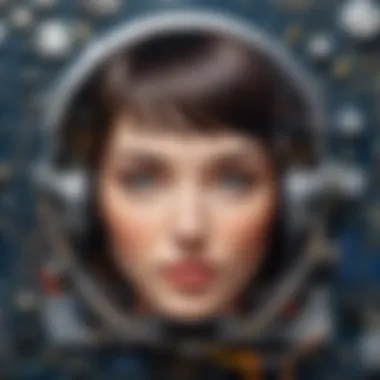

- Personalization: Tailoring content and recommendations based on user behavior can greatly enhance engagement. If users find puzzles that match their art preferences, they are more likely to return.
- Regular Updates: Continually adding new puzzles and features can keep users interested. This could mean introducing seasonal themes or collaborating with artists to create exclusive content.
- Community Building: Building a community through forums or social media can create a sense of belonging. Users may feel more connected when they can share their experiences or chat with others.
- In-game Rewards: Implementing systems that reward users for consistent engagement can foster loyalty. This may include unlockable content or achievements that encourage continued participation.
Art puzzle apps must employ diverse strategies to keep users from staying bored or moving to a competitor's app. A deep understanding of what drives user loyalty in the digital age is essential for maintaining a substantial user base.
"In a competitive tech environment, the ability to adapt and innovate determines which art puzzle apps will thrive and which will become obsolete."
The Role of Art Puzzle Apps in Society
Art puzzle apps play a significant role in modern society, intersecting technology and culture in profound ways. These applications are not merely entertainment; they contribute to the enrichment of collective cultural knowledge and promote interaction with art in innovative manners. The relevance of such tools is evident in their ability to bridge gaps between traditional art forms and contemporary digital experiences. The popularity of these apps underscores a transition in how we engage with art.
Cultural Impact
The cultural impact of art puzzle apps is substantial. By integrating art history, famous artworks, and various artistic styles into the puzzle-solving process, these apps serve as educational platforms. Users not only enjoy the challenge of completing puzzles but also gain insights into the artworks themselves. For instance, an app may feature a puzzle that includes Starry Night by Vincent van Gogh, allowing users to learn about the artist's background and the painting's significance within the context of the Post-Impressionist movement.
Moreover, the exposure to diverse artistic expressions fosters a sense of appreciation for different cultures. People may encounter works they otherwise would not, leading to a greater understanding of global artistic traditions. In this sense, art puzzle apps can be seen as a tool for cultural exchange, providing users with a visual exploration of world art that surpasses geographical boundaries.
Key Points of Cultural Impact:
- Educational value through art history integration.
- Facilitates exposure to diverse artistic styles.
- Promotes appreciation of global cultures.
"Art puzzle apps are more than games; they are gateways to understanding and appreciating art and culture."
Accessibility to the Art World
Accessibility is another critical element in discussing the role of art puzzle apps within society. Traditional art appreciation often requires access to physical galleries and museums, which may not always be feasible for everyone. Art puzzle apps democratize the world of art, making it available to anyone with a smart device. They eliminate barriers such as distance, financial constraints, or even physical disabilities that may prevent individuals from visiting art locations.
These apps often come with various features that cater to users with different needs and backgrounds. Some apps provide audio descriptions for visually impaired users, while others include multilingual support, helping non-native speakers engage with the app content. This consideration for accessibility underscores a commitment to inclusivity within the art environment.
Benefits of Accessibility to the Art World:
- Broadens access to art for users regardless of location.
- Incorporates features for differently-abled individuals.
- Supports multilingual users, fostering global participation.
Future Prospects for Art Puzzle Apps
The realm of art puzzle apps is evolving rapidly, presenting unique opportunities and challenges. Their future prospects are essential to consider as they bridge technology and creativity. In a digital landscape where users seek interactive and enriching experiences, these apps hold potential to revolutionize how art is perceived and enjoyed. The advancement of technology, combined with user engagement trends, shapes the path forward for these applications.
Emerging Trends
As technology continues to advance, several trends are becoming apparent in the art puzzle app space.
- Incorporation of Augmented Reality: New apps are using augmented reality (AR) to enhance the user experience. By allowing users to interact with art pieces in their own environment, AR brings a new dimension to puzzle solving.
- Personalization Through AI: Artificial intelligence is increasingly applied to curate personalized puzzle experiences. Users might receive recommendations based on their preferences, enhancing engagement and fostering a deeper emotional connection with the art displayed.
- Social Integration: Sharing completed puzzles on platforms like Facebook or Reddit may become commonplace. Users seek community interaction, prompting developers to incorporate social features that allow for sharing achievements and art discoveries.
- Collaboration with Artists: Partnerships with contemporary artists provide exclusive content for puzzle apps, making the puzzles not just challenging but also a way to support artists and promote their work.
- Gamification Elements: This trend encourages users to play more through rewards and achievements. By introducing levels, badges, and leaderboards, apps can increase user retention and satisfaction.
Predictions for Advancement
Predicting the future of art puzzle apps involves considering both advancements in technology and shifts in user behavior.
- Growth of Cross-Platform Compatibility: As users access apps from various devices, ensuring seamless experience across smartphones, tablets, and desktops can make these apps more appealing to a broader audience.
- Increased Focus on Education: Apps may evolve to feature educational components alongside puzzle-solving elements. This could include historical context for each artwork, artist bios, or techniques, prompting a more enriching experience.
- Sustainability Initiatives: In light of increased environmental awareness, developers might prioritize sustainable practices in app creation and encourage users to engage in eco-friendly activities through in-app features.
- Global Expansion: As art puzzle apps gain popularity, there will be opportunities for reaching diverse cultures and art forms. Localization efforts will be essential in creating content that resonates with different audiences.
- Enhanced User Engagement through Virtual Reality: The technology behind virtual reality (VR) is becoming more accessible. Future art puzzle apps might use VR elements to allow users to dive into famous artworks or historical art scenes, creating immersive puzzle experiences.
The outlook for art puzzle apps is not only about how they function but about how they influence and engage society in appreciating art.
End
In this article, we explored the intricate layers of art puzzle apps, revealing their significance in both technological and cultural realms. Art puzzle apps are not mere digital distractions; they serve several essential roles. These applications contribute to cognitive improvement, art appreciation, and even community engagement. By examining the various facets of these apps, we can appreciate why they have captured the interest of art enthusiasts and casual users alike.
Recap of Key Points
Several important aspects emerged from our discussion:
- User Experience: A well-designed interface enhances user satisfaction and engagement, driving more extensive usage.
- Diverse Content: The variety of art pieces available in these apps caters to different tastes, enabling users to discover new artists and styles.
- Cognitive Benefits: Engaging with puzzles stimulates mental acuity, improving problem-solving skills and fostering creativity.
- Art Community Impact: Art puzzle apps play a role in making art more accessible, encouraging a broader audience to explore artistic expressions.
- Future Trends: With emerging technologies such as augmented reality and artificial intelligence, the potential for these apps is continually expanding.
Final Thoughts on Art Puzzle Apps
Art puzzle apps identify an intersection between technology and culture. They reflect society's shifting landscapes and highlight the increasing merger of leisure and learning experiences. As new features and functionalities are introduced, these apps may transform not only how we engage with art but also how we perceive the role of technology in enhancing our cultural literacy. The hopeful future for art puzzle applications lies in their ability to democratize art appreciation and spark interest in creativity among a wide audience.
"The fusion of art and technology creates opportunities for engagement that were unimaginable just a few years ago."







